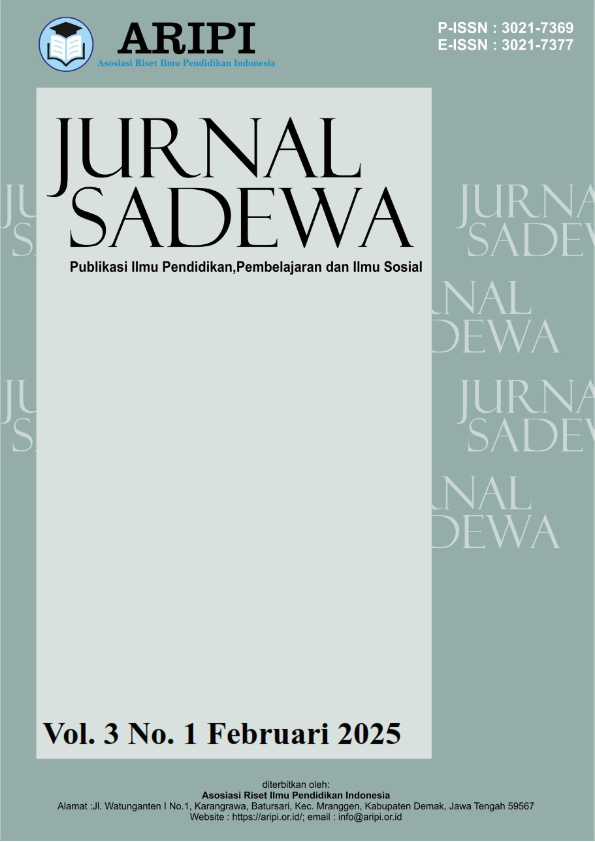Pengaruh Model PBL Melalui Pendekatan Diferensiasi Materi Penjumlahan Siswa SD Kelas 1
DOI:
https://doi.org/10.61132/sadewa.v3i1.1557Keywords:
quasi-design, experiment, Problem Based LearningAbstract
This research aims to determine the effect of the Problem Based Learning learning model through a material differentiation approach on the addition ability of grade 1 elementary school students at SDN Ngagelrejo I/396 Surabaya. The material differentiation approach is carried out by adjusting the level of difficulty of the addition material based on individual student abilities. This research used a quasi-experimental design with two groups, namely an experimental group that received learning using the PBL model and a material differentiation approach, and a control group that received conventional learning. The research subjects were grade 1 students at SDN Ngagelrejo I/396 Surabaya. Data was collected through addition ability tests before and after treatment. The results of the study showed that there was a significant difference between the addition abilities of students in the experimental group and the control group. The PBL model with a material differentiation approach has proven to be effective in improving the addition ability of grade 1 elementary school students at SDN Ngagelrejo I/396 Surabaya. This research recommends the use of the PBL model with a material differentiation approach in mathematics learning in elementary schools, especially at SDN Ngagelrejo I/396 Surabaya.
Downloads
References
Aini, N. R (2018). Analisis Kemampuan Berpikir Kritis Matematis Melalui Pendekatan Problem Based Learning Pada Mahasiswa Matematika UIN Raden Intan Lampung. I, 430-439.
Ari, A.A., & Katranci, Y. (2014). The Opinions of Primary Mathematics Students-teachers on Problem Based Learning Method. Procedia – Social and Behavioral Sciences, 116, 1826-1831.
Baharun, H. (2016). Pengembangan Media Pembelajaran Pai Berbasis Lingkungan melalui Model ASSURE. Cendekia: Journal of Education and Society, 142 (2), 231.
Cahyani, H., & Setyawati, R. W. (2016). Pentingnya Peningkatan kemampuan Pemecahan Masalah Melalui PBL untuk Mempersiapkan Generasi Unggul Menghadapi MEA. PRISMA, Prosiding Seminar Nasional Matematika, 151-160.
Fanani, M. Q., Wafiroh, Z., & Yaqin, M. H. (2022). Penerapan model problem based Learning (PBL) dalam pembelajaran berdiferensiasi untuk meningkatkan keterampilan berpikir kritis peserta didik pada pelajaran matematika. Proceeding Internasional Conference On Lesson Study, I (1), 537-548.
Harwina, W. (2021). Optimalisasi kebutuhan Murid dan hasil Belajar Dengan Pembelajaran Berdiferensiasi. Perspektif Ilmu Pendidikan, 35 (2), 175-182.
Jatmiko, H. T. P., & Putra, R. S. (2022). Refleksi Diri Guru Bahasa Indonesia Dalam Pembelajaran Berdiferensiasi di Sekolah Penggerak. Lingua Franca:Jurnal Bahasa, Sastra, Dan Pengajarannya, 6 (2), 224.
Jose M. Ocampo, J., & Rene F. Balencina. (2018). Effecting Chande on Students’ Critical Thingking in Problem Solving. Educare, 10(2), 109-118.
Kusumawati, K., Kusumadewi, R. F., & Ulia, N. (2019). Analisis Pemahaman Konsep Matematika Siswa SD pada Model Pembelajaran Problem Based Learning Berbantuan Media Pop Up. Konferensi Ilmiah Mahasiswa Unissula (KIMU), 207.
Marlina. (2019). Panduan Pelaksanaan Model Pembelajaran Berdiferensiasi di Sekolah Inklusif. 1-58.
Downloads
Published
How to Cite
Issue
Section
License
Copyright (c) 2025 Jurnal Sadewa : Publikasi Ilmu Pendidikan, pembelajaran dan Ilmu Sosial

This work is licensed under a Creative Commons Attribution-ShareAlike 4.0 International License.






